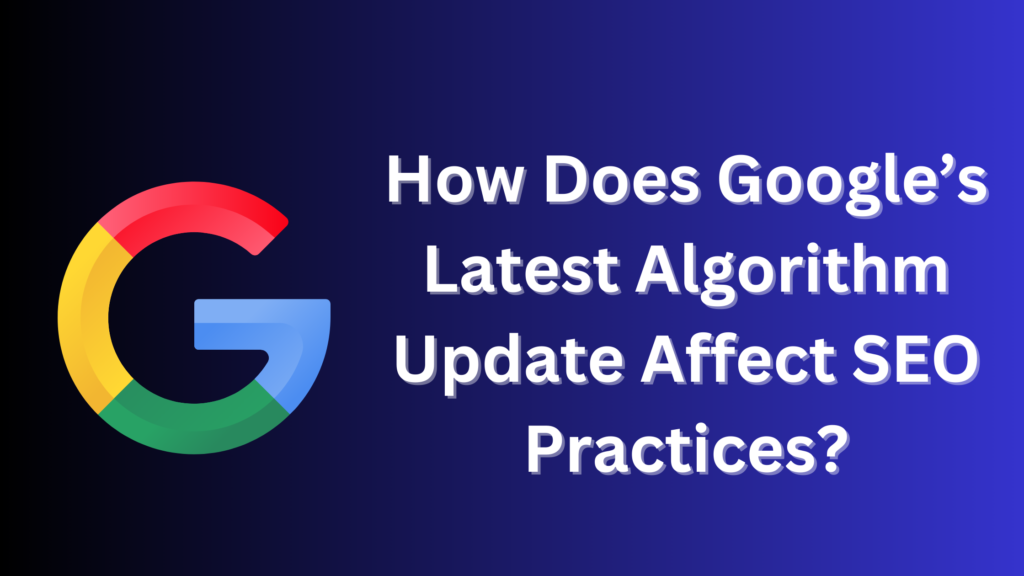
In the ever-evolving landscape of digital marketing, keeping pace with Google’s frequent algorithm updates is crucial for businesses and SEO practitioners. Each algorithm change can significantly impact website rankings, making it essential to understand how these updates affect SEO practices. This article explores the latest Google algorithm update, its implications on SEO strategies, and how businesses can adapt to stay competitive.
Understanding Google’s Algorithm Updates
Google frequently updates its search algorithm to improve user experience by delivering more accurate, relevant, and trustworthy search results. These updates focus on several factors, such as content quality, website performance, user experience (UX), and mobile-friendliness. While most updates are minor, Google occasionally rolls out major core updates that can dramatically alter search rankings.
What’s New in Google’s Latest Update?
The most recent Google algorithm update, released in 2024, emphasizes content relevance and user intent. Here’s a breakdown of the key changes:
- E-A-T (Expertise, Authoritativeness, and Trustworthiness): Google continues to prioritize websites that demonstrate E-A-T, especially for “Your Money, Your Life” (YMYL) content. It affects industries such as finance, health, and law, where accuracy is crucial.
- Helpful Content System Update: A major part of this update is Google’s focus on identifying and rewarding human-first content. Websites that provide original, insightful, and genuinely useful information are more likely to rank higher.
- Mobile-First Indexing: Mobile usability remains a top-ranking factor. Websites that aren’t mobile-optimized risk lower rankings, as the algorithm now evaluates mobile versions before desktop.
- Page Experience and Core Web Vitals: Google’s update reinforces the importance of site speed, interactivity, and visual stability. Websites with poor Core Web Vitals scores (such as slow loading times or poor layout shifts) may experience ranking drops.
- AI-Generated Content: While AI-generated content is becoming more prevalent, Google’s update emphasizes that human oversight is crucial. Google penalizes low-quality, machine-generated content that offers little value to users.
“Tired of poor rankings? Our SEO agency in East Delhi helps you drive traffic, improve visibility, and grow your business with proven strategies. Start dominating Google today!”
How These Changes Impact SEO Practices
- Focus on High-Quality, Human-Centric Content
Google’s updates reinforce the need for valuable, original content that addresses the user’s intent. AI-generated or overly optimized content created solely for search engines will no longer cut it. Instead, businesses should focus on:
- Creating informative, engaging content that answers users’ questions thoroughly.
- Ensuring content relevancy by using natural, user-friendly language.
- Prioritizing long-form content that provides depth, supported by data and authoritative sources.
Actionable Tip: Use tools like Google Search Console to monitor keyword performance and adjust content strategies accordingly. Also, ensure that every piece of content is tailored to meet the needs of your target audience, enhancing its usefulness and relevance.
- E-A-T Principles Are More Important Than Ever
Google’s continued emphasis on E-A-T means that businesses need to build credibility online. It is especially important for websites offering professional advice, such as financial or health-related content.
- Build author profiles to demonstrate expertise, including credentials, affiliations, and published work.
- Acquire backlinks from high-authority sites in your industry to strengthen your website’s authoritativeness.
- Regularly update content to maintain accuracy and relevance, especially for time-sensitive information.
Actionable Tip: Incorporate author bios for all your articles and make sure they highlight the expertise of the writer. Have content reviewed by experts in your field.
- Optimize for Mobile and Improve User Experience
Google’s mobile-first indexing means that mobile optimization is non-negotiable. If your website doesn’t offer a seamless mobile experience, your rankings will likely suffer.
- Ensure your website is responsive and adapts well to different screen sizes.
- Improve page loading speeds to meet Google’s Core Web Vitals thresholds. Tools like Google PageSpeed Insights can help you identify areas for improvement.
- Focus on creating clean, easy-to-navigate designs that provide an intuitive user experience.
Actionable Tip: Prioritize mobile-friendly layouts, minimize image file sizes, and streamline code to improve site performance. Check Google’s Mobile-Friendly Test tool to ensure your site is optimized.
- Focus on Core Web Vitals for Page Experience
Core Web Vitals have become a significant ranking factor. These metrics measure your website’s loading speed, interactivity, and visual stability. Sites that perform poorly in these areas will find it harder to rank.
- Largest Contentful Paint (LCP): Your website’s largest content element should load quickly.
- First Input Delay (FID): Ensure that your site responds quickly to user interactions.
- Cumulative Layout Shift (CLS): Avoid unexpected layout shifts to provide a stable viewing experience.
Actionable Tip: Use tools like Lighthouse and GTmetrix to track and optimize Core Web Vitals performance.
- Shift Toward Human-AI Collaboration
While AI-generated content is becoming more popular, Google’s algorithm still favours human touch and editorial oversight. Ensure that AI tools supplement your content creation, not replace it entirely.
- Use AI for content ideation, keyword research, and data analysis, but keep content creation focused on human input.
- Review AI-generated content for accuracy and ensure it aligns with user intent.
Actionable Tip: Tools like ChatGPT or Jasper AI can help streamline content creation, but make sure you edit and optimize these outputs to maintain quality and human relevance.
Conclusion
Google’s latest algorithm update underscores the importance of user-centric content, mobile optimization, and Core Web Vitals. By focusing on providing genuine value, adhering to E-A-T principles, and improving website performance, businesses can navigate these changes effectively. Stay proactive by monitoring your SEO metrics and regularly updating your strategy to align with Google’s evolving guidelines.